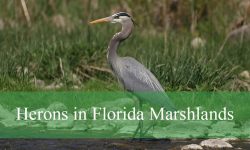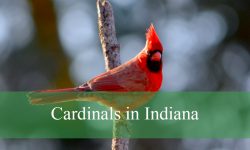In their natural environments, birds with long necks display grace and versatility, making them intriguing creatures. Their lengthy necks are used for more than simply showing; they are crucial for communication, foraging, and even courtship displays. These birds, which range in size from majestic storks to graceful herons, enthrall with their unique characteristics.
Let’s investigate the amazing lifestyles of birds with long necks and delve into their world through this article
Different Types of Birds with Long Necks
Scarlet Ibis
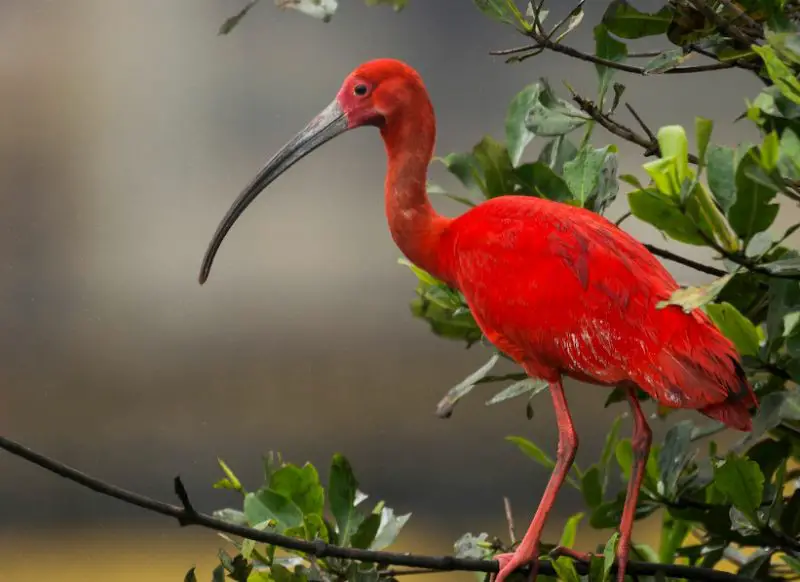
The gorgeous Scarlet Ibis, a beautiful bird that graces South American marshes. Their wingspan is 20 to 22 inches, and they weigh 1.5 to 3 lbs. They range in size from 22 to 30 inches. Their striking red feathers, which contrast with the black tips of their wings, are evidence of their diet’s high crustacean and crab content.
However, they can consume a wide range of other treats, including fish eggs, frogs, lizards, insects, and even tiny snakes. Despite having lifelong monogamous relationships with their partners, they are gregarious creatures that frequently congregate in large flocks. Notably, they are recognized as Trinidad and Tobago’s national bird, an esteemed distinction.
Tundra Swan
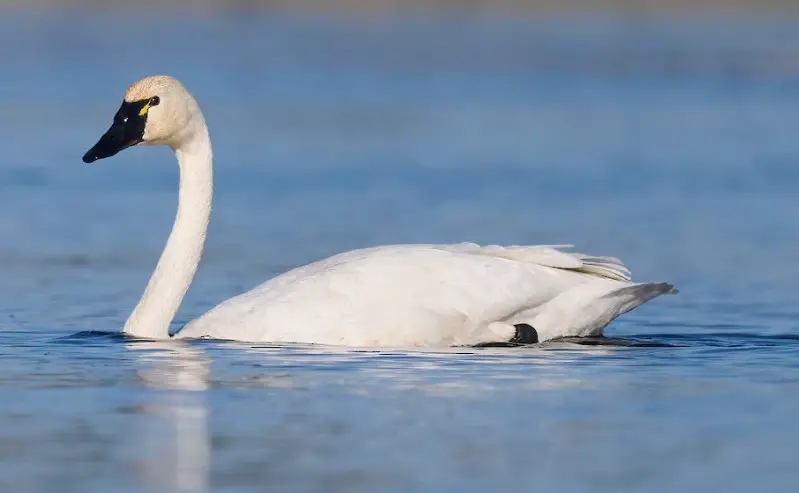
The Tundra Swan, scientifically known as Cygnus columbianus, is a majestic bird of the Arctic. With a size ranging from 36 to 54 inches and weighing 13 to 20 lbs, they boast a wingspan of 72 to 84 inches.
Their elegant long necks aid in foraging in icy waters, where they exhibit a unique feeding behavior called “dabbling.” Female Tundra Swans lay approximately four eggs, which are incubated for 32 days while males guard the nest.
Cattle Egret
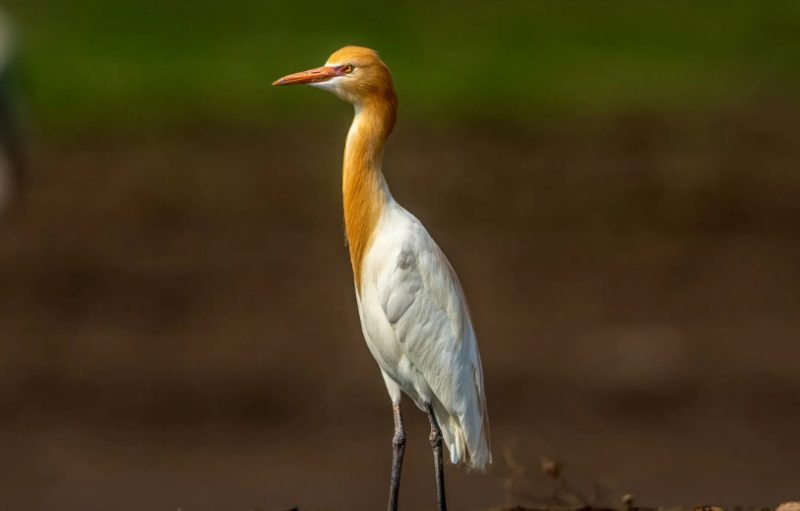
The Cattle Egret, scientifically known as Bubulcus ibis, stands between 19 to 21 inches tall and weighs 9.5 to 18.3 ounces, with a wingspan of 34 to 36 inches. Despite its hunched posture, this bird adapts well to grasslands, woodlands, and wetlands.
Known for its dual role in agriculture, it acts as a pest control agent in pastures and croplands but can also pose a threat in naturally grazed habitats. Social creatures, Cattle Egrets thrive in groups, exhibiting communal roosting and foraging behaviors.
Black Swan
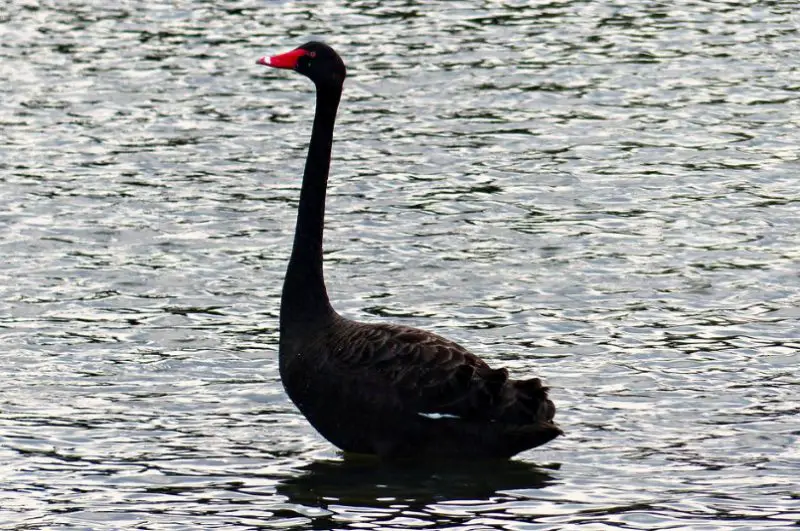
The Black Swan, scientifically known as Cygnus atratus, stands out with its curved long neck and striking black plumage, contrasting with white wingtips and reddish-orange beaks. Sized between 43 to 56 inches and weighing 8.1 to 20 pounds, with a wingspan of 63.6 to 78 inches, they can live up to 40 years.
Adaptable to various wetland habitats, they primarily feed on algae and weeds, utilizing their long necks to forage in waters up to one meter deep. While adept swimmers, they may appear clumsy on land.
Black-Headed Heron

The Black-Headed Heron, scientifically named Ardea melanocephala, stands at 33.5 inches tall, weighing between 24.3 to 25.8 ounces, with a wingspan of 59.1 inches. Found in sub-Saharan Africa and Madagascar, they boast dark heads and napes, contrasting with white throats and grey upper wings.
Their diet is diverse, including rodents, beetles, lizards, crabs, snakes, frogs, fish, grasshoppers, and other arthropods. Both male and female herons contribute to nest-building, with males gathering twigs and branches while females construct the nests.
Double-Crested Cormorant
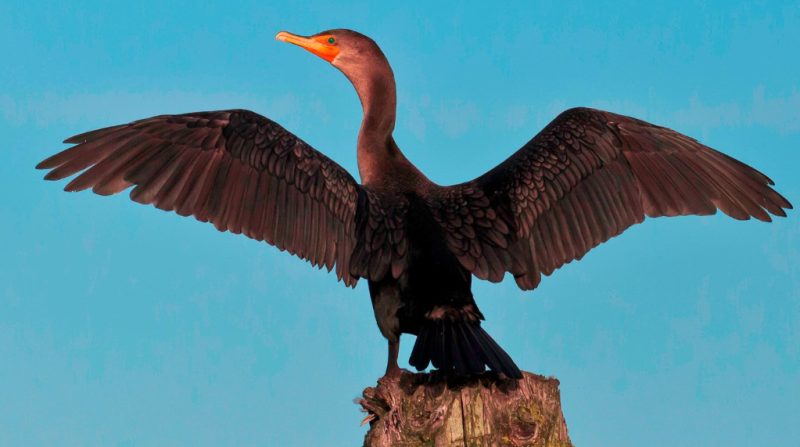
The long-necked Double-Crested Cormorant, scientifically named Nannopterum auritus. Ranging from 27 to 33 inches and weighing 3.3 to 6.6 lbs, with a wingspan of 45 to 52 inches, they excel in diverse habitats like coasts, bays, lakes, rivers, and cliffs.
Primarily piscivorous, they exhibit a colorful transformation during breeding season, with vivid orange throats contrasting their dark feathers. Known for their elite diving skills, they can hold their breath for several minutes and plunge up to 150 feet deep to catch fish.
Kori Bustard
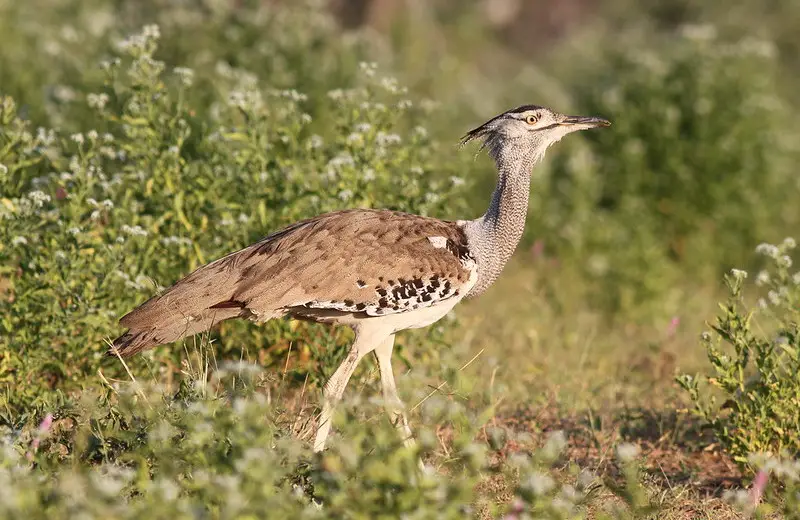
The Kori Bustard, scientifically known as Ardeotis kori, is Africa’s heaviest flying bird, spanning 24 to 60 inches in size and weighing 24 to 42 pounds. Their robust, long necks are a notable feature as they roam grasslands and wooded savannahs.
Despite their hefty weight, they exhibit adaptability in flight. While insects are vital during their chick phase, their diet expands to include small mammals, lizards, snakes, seeds, and berries. Classified as “Near-Threatened” by the IUCN, these birds face population declines.
Little Blue Heron

The Little Blue Heron, scientifically known as Egretta caerulea, measures between 22 to 29 inches, weighing 10.4 to 14.5 ounces, with a wingspan of 39 to 41 inches. Despite its often hunched stance, its elongated neck becomes unmistakable during hunting.
Known for their dark slate-blue feathers, purple-maroon heads and necks, and skinny legs, these herons forage methodically in shallow waters for fish, insects, shrimp, and amphibians. While they are often solitary, they breed in communal nesting sites called rookeries and roost in large flocks at night.
Purple Heron
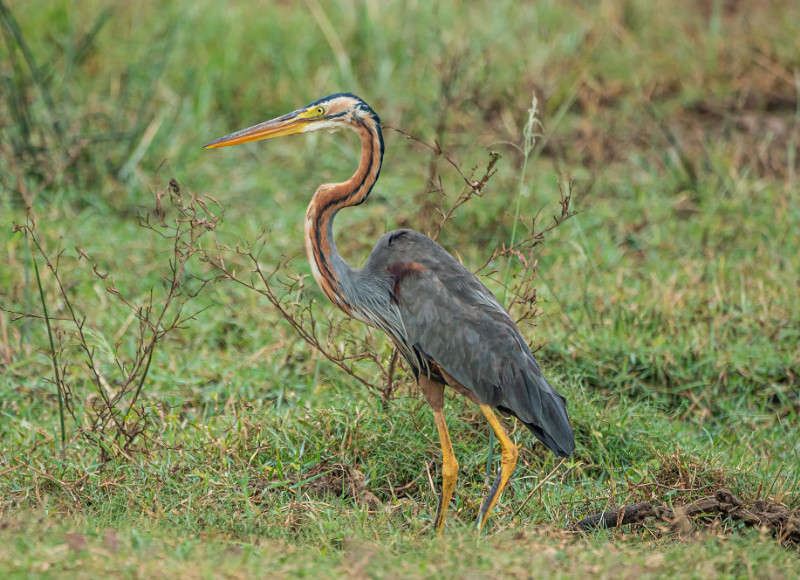
The Purple Heron, scientifically named Ardea purpurea, stands between 30.7 to 38.1 inches tall, weighing 1.4 to 2.7 pounds, with a wingspan of 47.2 to 59.8 inches.
Found across Asia and Africa, they’re recognized for their unique “S” shape neck in flight. Both males and females exhibit purple-brown plumage with slate-grey wings, a reddish-brown breast, a black belly, and reddish-purple flanks.
Notoriously secretive, they blend into their surroundings and communicate sparingly, aiding in their survival strategy. They swallow prey whole, regurgitating undigestible parts as pellets.
Common Ostrich
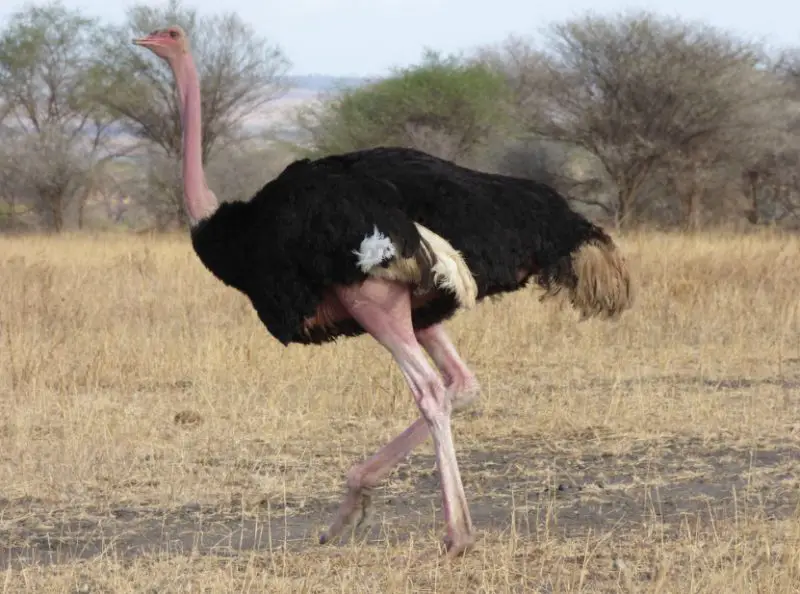
The Common Ostrich, scientifically named Struthio camelus, commands attention with its towering stature. Ranging from 68.4 to 108 inches in height and weighing 198 to 287 pounds, they possess a wingspan of 78.7 inches. Known for their aggressive behavior, they adapt surprisingly well to human interaction, exhibiting less stress when accustomed from a young age.
Despite their formidable presence, they can be surprisingly curious and approachable, as observed on ostrich farms. In the wild, they display remarkable speed, sprinting up to 43 miles per hour to evade predators.
Sandhill Crane
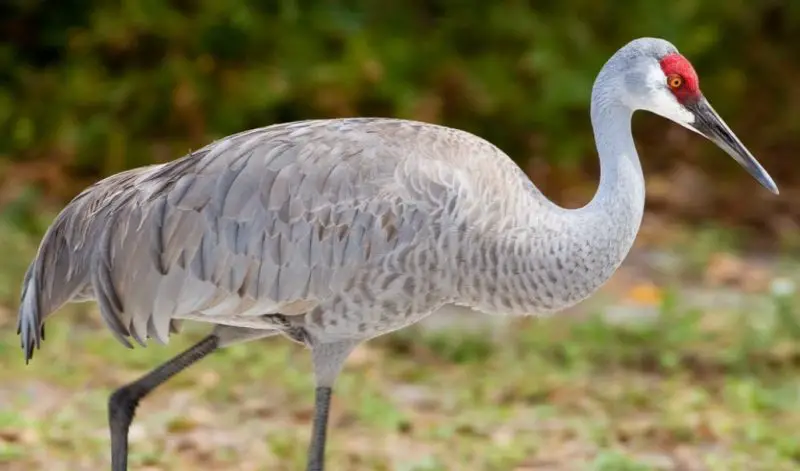
The Sandhill Crane, scientifically known as Grus canadensis, stands between 38.4 to 46.8 inches tall, weighing 7 to 11 pounds, with a wingspan of 70.8 to 78 inches. Thriving in freshwater wetlands, they are recognized for their long necks and legs.
Social by nature, they enjoy mingling with other birds. Their trumpeting calls, produced by an elongated trachea, are a distinctive feature, with the ability to control pitch based on context.
Limpkin
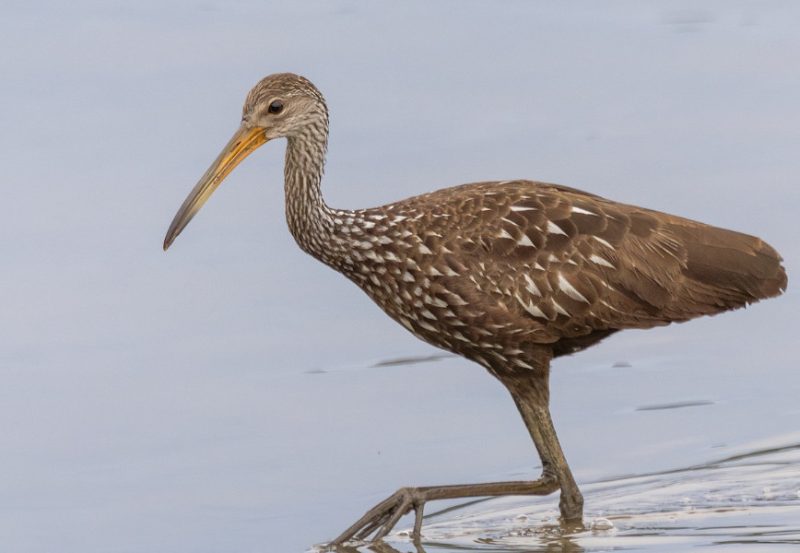
The Limpkin, scientifically named Aramus guarauna, measures between 23 to 28 inches and weighs 2.4 to 3 pounds, with a wingspan of 40 to 42 inches. Found mainly in southern Georgia and Florida, they stand out with their long necks.
As the sole representative of their family, Aramidae, they play a unique ecological role by primarily feeding on apple snails, helping control their population, and maintaining aquatic ecosystems. Additionally, they consume insects, worms, and mussels.
Sarus Crane
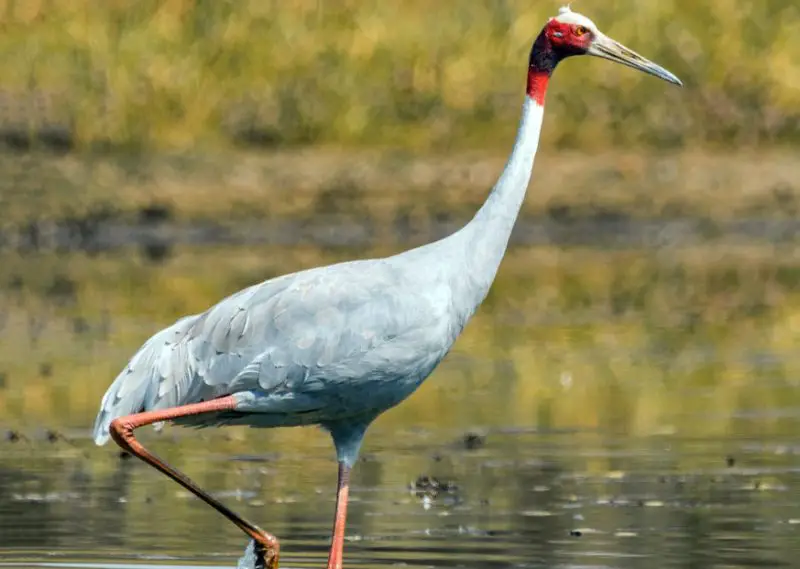
The Sarus Crane, scientifically named Grus antigone, stands between 69.6 to 72 inches tall, weighing 11 to 26 pounds, with a wingspan of 86.6 to 98.4 inches. Found in the Indian Subcontinent, Southeast Asia, and Australia, they are the tallest flying birds. Despite their impressive stature, they face conservation challenges, being listed as “Vulnerable” by the IUCN.
Known for their elaborate mating dances, they showcase head bobbing and wing flapping. They’re skilled flyers, reaching speeds between 40 to 70 kilometers per hour, although this brings risks like collisions with power lines.
Black Stork
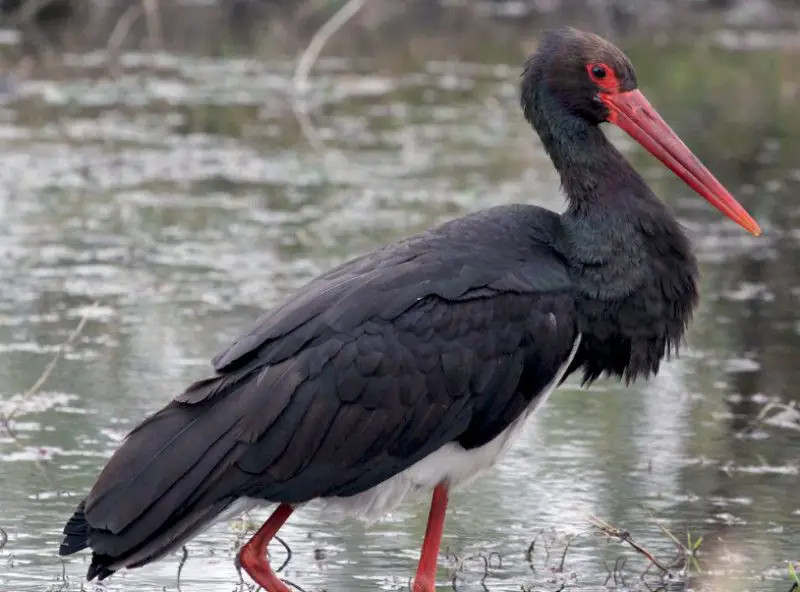
The Black Stork, scientifically known as Ciconia nigra, ranges from 35.4 to 41.3 inches tall, weighing 5.3 to 7.1 pounds, with a wingspan of 56.7 to 61 inches.
Found in Europe, Asia, and Africa, they are known for their striking reddish-green plumage, white belly, long neck, and bright orange beak. While their numbers are not critically low, they face threats from predation by White-tailed Eagles.
They are opportunistic feeders, consuming various prey, including fish, mammals, and other birds. During courtship, they engage in aerial displays and bill-clattering.
White-Faced Heron
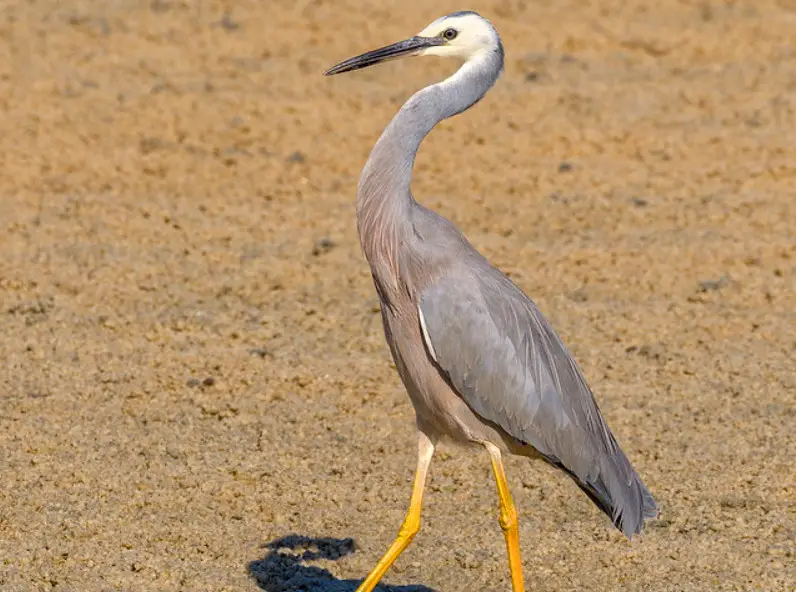
The White-faced Heron, scientifically named Egretta novaehollandiae, measures between 23.6 to 27.6 inches and weighs 19.4 ounces, with a wingspan of 41.3 to 43.3 inches. Found in Australia, New Guinea, and New Zealand, they are distinguished by their long necks and characteristic white faces, set against bluish-gray plumage.
While often solitary, they exhibit flexibility in behavior, sometimes interacting with other birds for mutual benefit. These herons are known for their boldness in approaching human settlements, often perching on fence posts, trees, or rooftops.
Intermediate Egret
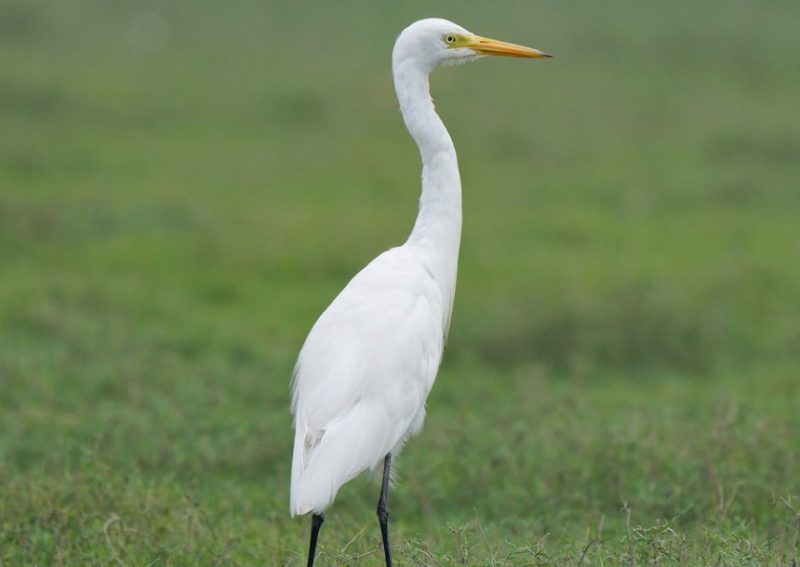
The Intermediate Egret, scientifically known as Ardea intermedia, measures between 23 to 27 inches and weighs 14.1 ounces, with a wingspan of 42 to 46 inches.
Recognizable by their long necks, slender frames, white plumage, yellow bills, and black legs, they typically prefer solitude but may gather in small groups. Often mistaken for Great Egrets, they can be distinguished by their upright stalking posture.
Reddish Egret
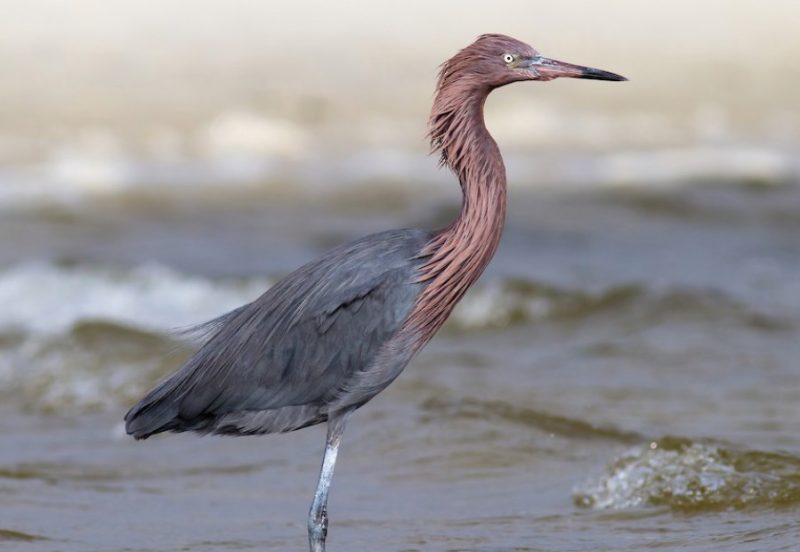
The Reddish Egret, scientifically known as Egretta rufescens, stands out with its lengthy nape, shaggy plumage, red head and neck feathers, thick bills, and long legs. Sized between 27 to 32 inches and weighing 24.7 to 26.5 ounces, with a wingspan of 46 to 48 inches, they are rare in North America and are facing threats due to poorly planned tourism and urban expansion. Notably, they are most active during dawn and dusk.
Brolga
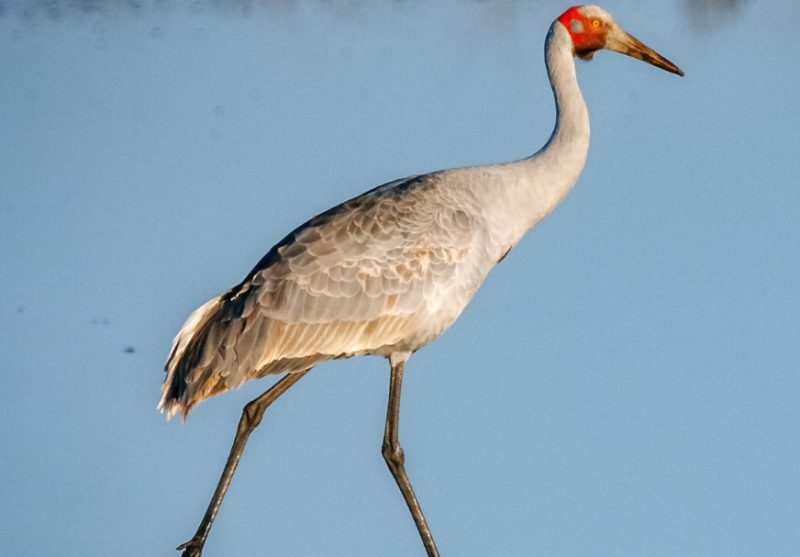
The Brolga, scientifically known as Grus rubicunda, boasts a long neck and sociable nature within the Gruidae family. Ranging from 39.4 to 49.2 inches in size, weighing 10.6 to 19.2 pounds, with a wingspan of 66.9 to 94.5 inches, they inhabit various Australian landscapes. Their diverse diet includes sedge tubers, crops, mollusks, invertebrates, small vertebrates, and crustaceans.
American Bittern

Residing in the northern marshlands, the American Bittern, or Botaurus lentiginosus, features a long neck, aiding in its stealthy hunting. Ranging from 23 to 34 inches in size, weighing 0.8 to 1.1 pounds, and with a wingspan of 36 to 50 inches, they patiently await prey at the water’s edge before swiftly capturing them with their yellow bills.
Their diet includes catfish, eels, tadpoles, killifish, perch, dragonflies, frogs, crabs, saltwater insects, salamanders, and garter snakes.
Snowy Egret
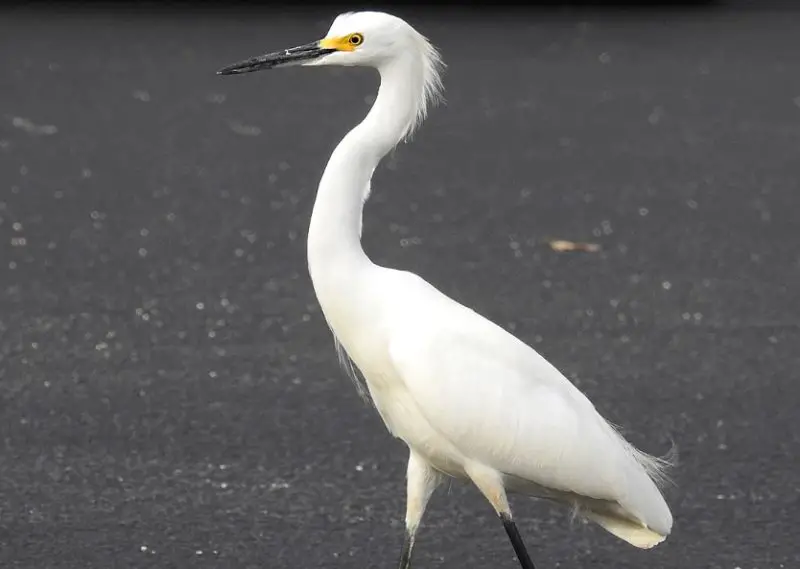
The Snowy Egret, scientifically known as Egretta thula, boasts a long neck and slender frame, spanning 20 to 27 inches in size and weighing 13.1 ounces, with a wingspan of 39 to 41 inches. Often found in coastal regions, they exhibit social behavior, foraging alongside various bird species and nesting communally during the breeding season.
Their diet primarily consists of small fish, rodents, crustaceans, amphibians, reptiles, and marine insects.
Western Reef-Heron
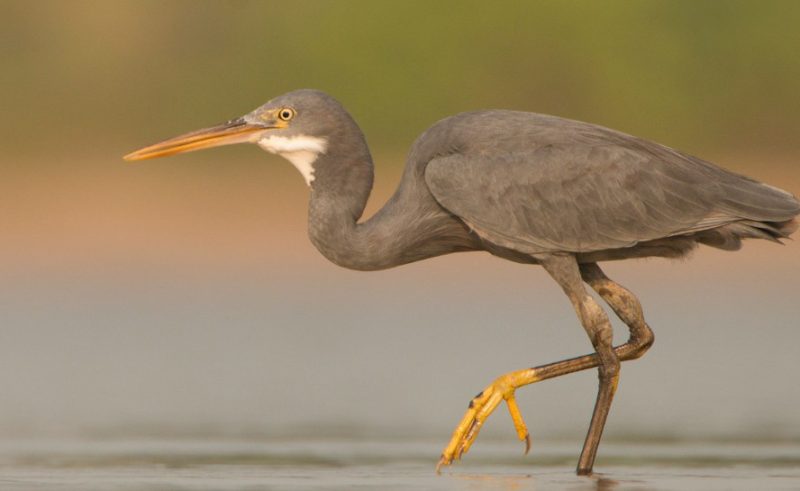
The Western Reef-Heron, scientifically known as Egretta gularis, stands out with its long neck, measuring 22 to 26 inches and weighing 14.1 ounces, with a wingspan of 33.9 to 42.9 inches. They exhibit three distinct color morphs: slate-gray, white, and pale gray. These birds employ patient foraging techniques, such as “Stand and Wait” and “Walking Slowly,” to catch prey along tropical coastlines.
Wood Stork
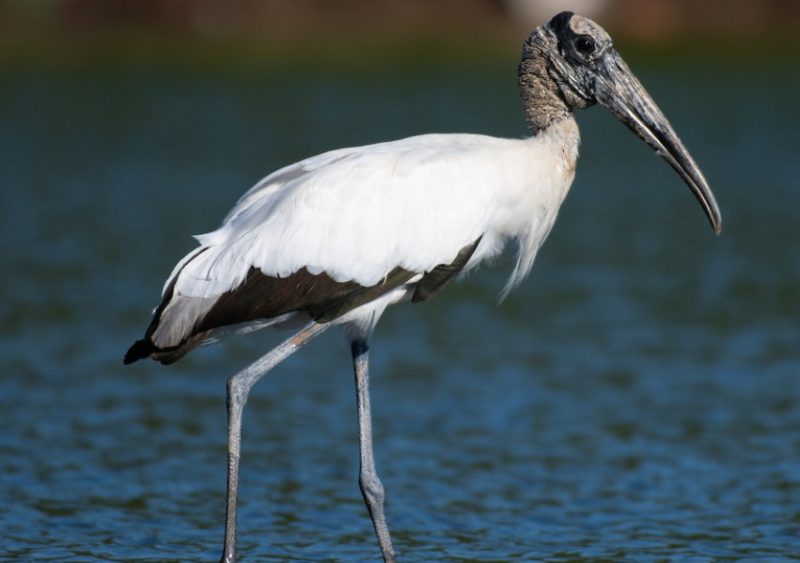
The Wood Stork, scientifically named Mycteria americana, stands tall with a size ranging from 35 to 45 inches and weighing 4 to 6 pounds, with a wingspan of 60 to 65 inches. Their distinctive features include elongated necks, football-shaped bodies, massive beaks, and long, white legs.
These social birds often forage and nest in groups, showcasing their community-oriented behavior. You can find them in mixed hardwood swamps, sloughs, and mangroves across North America. Despite their tall stature, Wood Storks are skilled fliers, soaring at altitudes up to 6,000 feet.
Anhinga
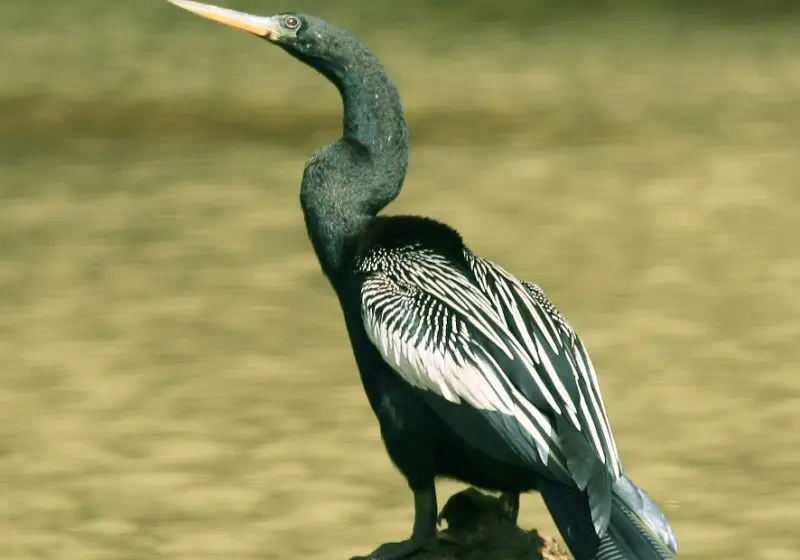
The Anhinga, scientifically named Anhinga anhinga, stands out with a size ranging from 32 to 36 inches and weighing about 2.5 pounds, with a wingspan of 43 to 47 inches. Known as the “snake bird” due to its elongated neck, it also resembles a turkey, earning it the nickname “water turkey.” Surprisingly, Anhingas are expanding their range northward due to climate change, now being sighted as far as New York.
Despite lacking waterproof feathers, these carnivorous birds adeptly navigate underwater to hunt for small fish, shrimp, amphibians, crayfish, and even young alligators and snakes.
Saddlebill

The Saddlebill, scientifically known as Ephippiorhynchus senegalensis, is an impressive sight across tropical Africa. Standing tall with a size ranging from 52.8 to 58.8 inches and weighing 11 to 16 pounds, it boasts distinctive black-and-white plumage and a vibrant red beak.
These storks are typically solitary, occasionally foraging alone or in pairs. Interestingly, they communicate through actions like “bill-clattering” rather than vocalizations.
American Flamingo

The American Flamingo, scientifically known as Phoenicopterus ruber, boasts impressive measurements: 47–57 inches in height, weighing 4–8 lbs, with a wingspan of 50–60 inches. Native to Florida, they use their long necks for hunting, wading gracefully through shallow waters to feed on aquatic creatures and algae.
Their pink hue, derived from their diet’s high β-carotene content, is a distinctive feature. These sociable birds often gather in large flocks, numbering up to 360,000 individuals.
Black-Necked Stork
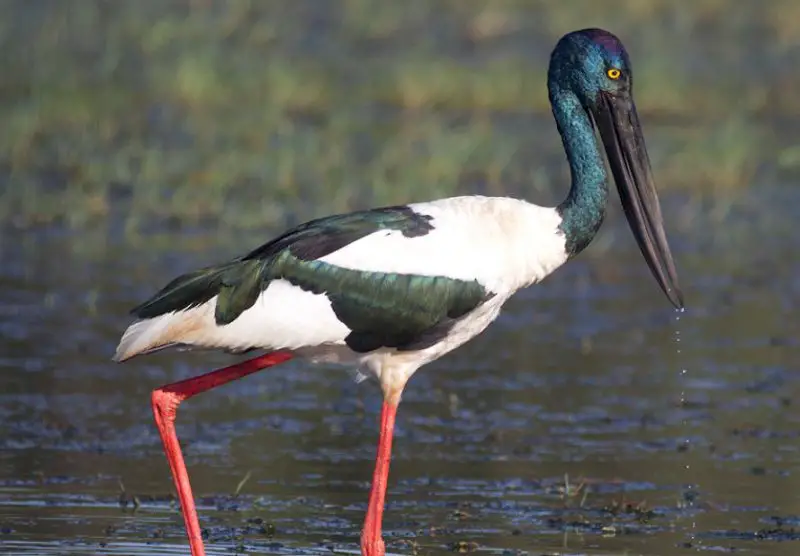
The Black-Necked Stork, scientifically named Ephippiorhynchus asiaticus, is a notable bird with a Near-Threatened conservation status. Standing between 47.2 to 59.1 inches tall and weighing 8.4 to 9 lbs, they boast a wingspan of 74.8 to 90.6 inches.
Commonly known as Jabiru, these storks are recognized by their long necks and are found across the Indian Subcontinent, Southeast Asia, and parts of Australia. They prefer freshwater wetlands but can also be spotted in paddocks and woodlands. Typically solitary, they feed on a diverse diet ranging from small insects to larger prey like eels and reptiles.
Wattled Crane
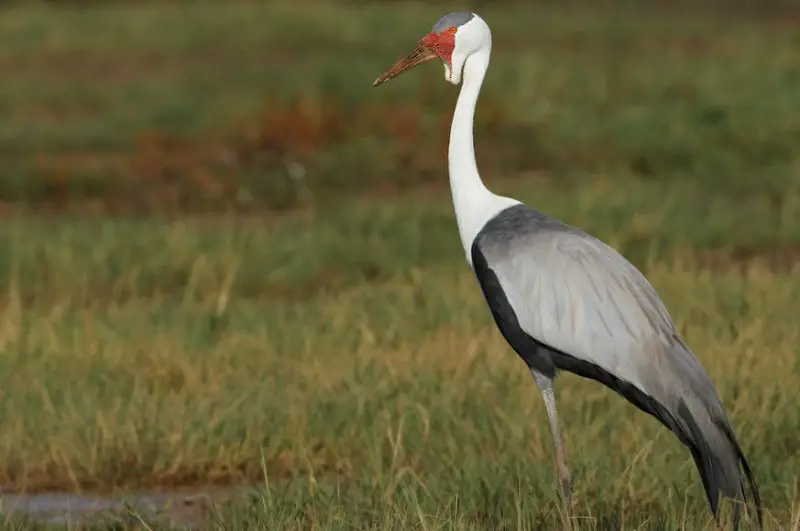
The Wattled Crane, scientifically named Bugeranus carunculatus, is a striking bird distinguished by its long white neck. It holds the title of Africa’s largest crane, standing up to 68.9 inches tall and weighing between 14 to 20 lbs, with a wingspan of 90 to 102 inches.
Recognizable by the white wattles hanging from their throat, they inhabit wetlands and grasslands, feeding on aquatic vegetation, seeds, tubers, and small reptiles. Despite their impressive stature and elaborate breeding displays, they are classified as “Vulnerable” by the IUCN Red List, signaling conservation concerns.
Tricolored Heron
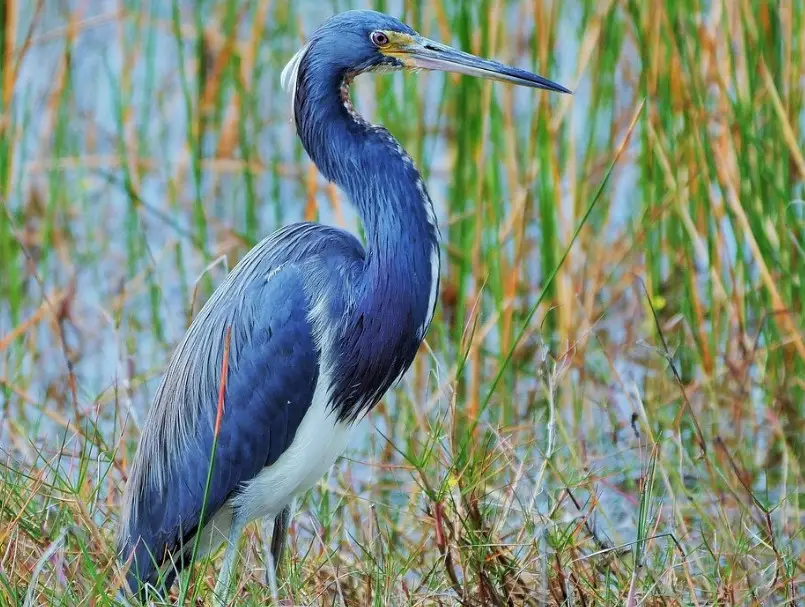
The Tricolored Heron, scientifically known as Egretta tricolor, boasts a slender build with a wingspan ranging from 36 to 38 inches (91.5–96.5 cm) and a height of 22–26 inches (55.9–66 cm). Weighing between 12 and 14 ounces (340.2–396.9 g), these herons can live up to 22 years.
Once referred to as Louisiana Herons, they display remarkable adaptability, favoring freshwater habitats for nesting and chick rearing. These solitary hunters employ cunning camouflage techniques, blending seamlessly into their surroundings when threatened, with bills pointing skyward as a defensive posture.
Roseate Spoonbill
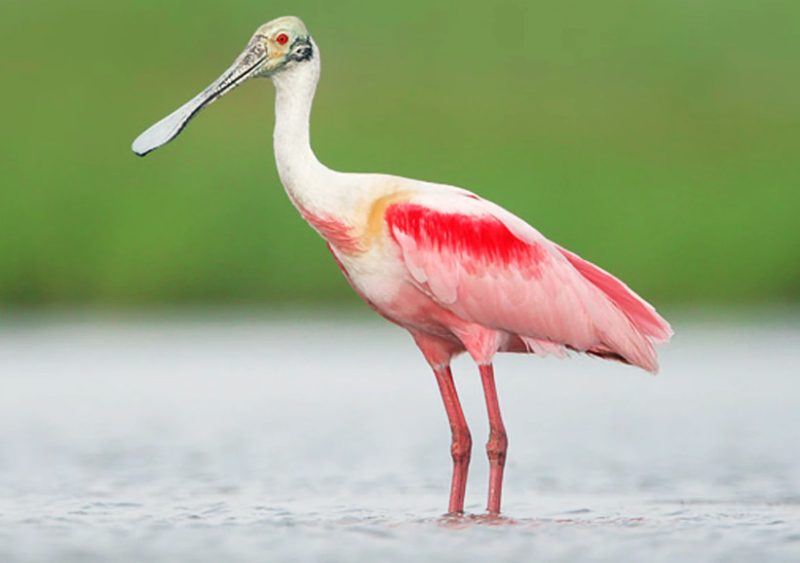
The Roseate Spoonbill, scientifically named Platalea ajaja, stands out with its striking appearance: a height of 32–34 inches (81.3–86.4 cm), weighing 2.6–4 lbs (1.2–1.8 kg), and boasting a wingspan of 50–53 inches (127–134.6 cm).
Their distinctive spoon-shaped bills and pink plumage make them easily identifiable. These birds thrive on a diet rich in shrimp, which gives them their vibrant pink hue. Despite their current non-endangered status, they face challenges from climate change, particularly in adapting to rising sea levels in their habitats, like Florida Bay.
A fascinating detail: Roseate Spoonbill chicks are born without their characteristic spoon-shaped bills, developing them as they mature and begin independent foraging.
Great Egret
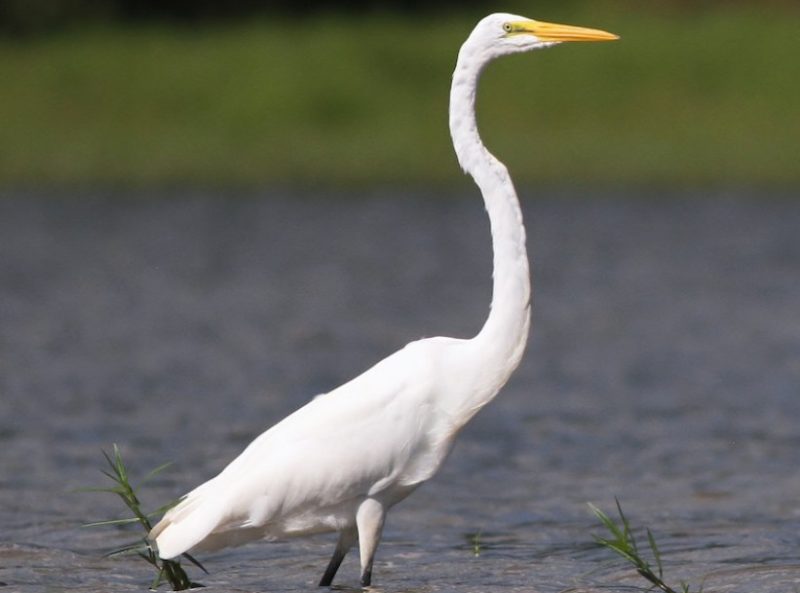
The Great Egret, scientifically labeled Ardea alba, stands tall with a height ranging from 36 to 39 inches (91.4–99.1 cm) and weighing between 2 to 2.5 lbs (0.9–1.1 kg), sporting a wingspan of 55 inches (139.7 cm). Renowned for its snowy-white plumage, slender physique, and dark legs, it’s a sight to behold.
Breeding from mid-April, they nest a clutch of 4 to 5 eggs, incubated for about 23 to 24 days. Their diet comprises mainly crustaceans and fish, although they opportunistically feed on insects and more.
An interesting historical tidbit: Great Egrets were once nearly extinct due to hunters coveting their plumes in the 1800s. Thankfully, conservation efforts led by the National Audubon Society saved them from the brink.
Great Blue Heron
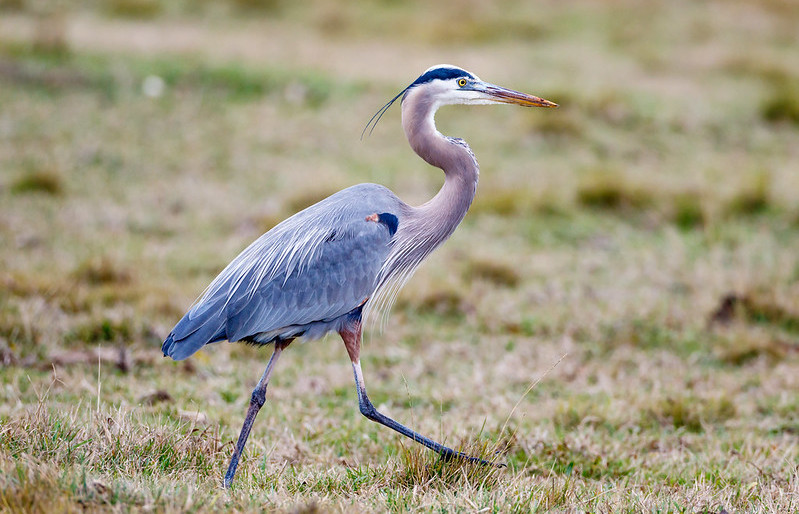
The Great Blue Heron, scientifically named Ardea herodias, is a majestic avian with a height spanning 38 to 54 inches (96.5–137.2 cm) and weighing between 5 to 6 lbs (2.3–2.7 kg), boasting a wingspan of 66 to 79.2 inches (167.6–201.2 cm). Recognizable by its long neck, it thrives in diverse aquatic habitats, from mangroves to Alaskan coasts.
Primarily piscivorous, they also indulge in insects, amphibians, crustaceans, and small animals. Their hunting technique involves stealthily stalking prey, utilizing their coiled neck to strike swiftly.
Despite their year-long monogamy, they select new mates annually, raising a single family each breeding season.
Whooping Crane
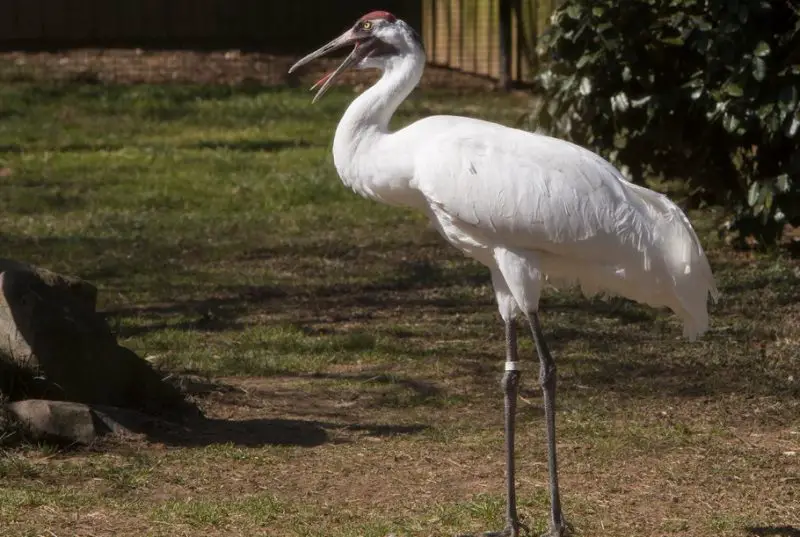
The Whooping Crane, scientifically termed Grus americana, commands attention with its towering stature, standing at 60 inches (152.4 cm) tall and weighing between 13.2 to 17.2 lbs (6–7.8 kg), boasting an impressive wingspan of 84 to 96 inches (213.4–243.8 cm).
Recognizable by its long neck, yellow eyes, black primaries, and a striking red patch on its head, this majestic bird is sadly endangered, with only about 550 individuals remaining.
Goliath Heron

The Goliath Heron, scientifically termed Ardea goliath, commands attention with its imposing stature, standing between 47 to 60 inches (119.4–152.4 cm) tall and weighing 8.8 to 11 lbs (4–5 kg), boasting a wingspan of 73 to 91 inches (185.4–231.1 cm). Preferring shallow waters, they employ a patient “jackpot” feeding strategy, targeting large fish like Barbels and Grunters.
Remarkably, they spend about 75% of their time motionless, showcasing their exceptional patience while waiting to catch just a few substantial prey items daily.
Greater Flamingo
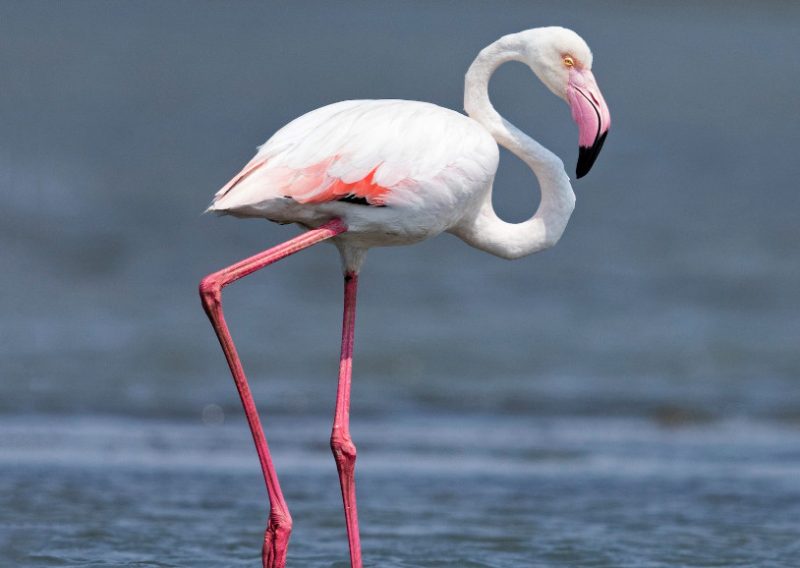
The Greater Flamingo, scientifically termed Phoenicopterus roseus, is easily recognizable by its elegant, elongated neck, standing between 46.8 to 56.4 inches (118.9–143.3 cm) tall and weighing 4.6 to 9 lbs (2.1–4.1 kg), with a wingspan of 55 to 67 inches (139.7–170.2 cm).
Notably, their population status is “Least Concern,” reflecting their thriving numbers across Africa, southern Europe, and Asia. A 2017 study revealed their remarkable parenting behavior, with both males and females dedicated to brooding, but males often taking the lead in incubation and nest defense—an unusual trait among birds.
Marabou Stork
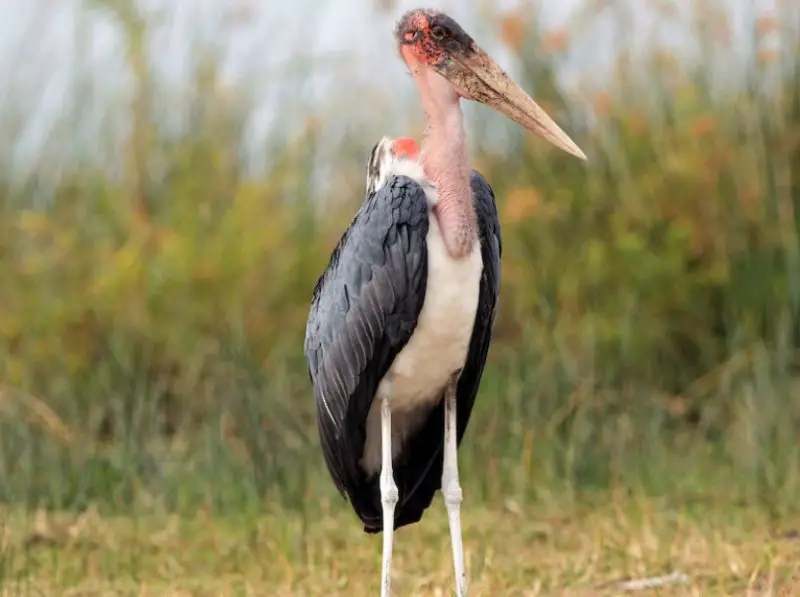
The Marabou Stork, scientifically known as Leptoptilos crumenifer, is a striking avian with a height ranging from 48 to 60 inches (121.9–152.4 cm) and weighing between 10 to 20 lbs (4.5–9.1 kg), boasting an impressive wingspan of 126 to 144 inches (320–365.8 cm). Notably, they’re recognized for their large dagger-like beaks and bare, pink heads.
As scavengers, they primarily feed on carrion, helping maintain ecosystem cleanliness. Their diet also includes other birds and their chicks, setting them apart from their piscivorous relatives. They inhabit wetlands with ample nesting materials, but also thrive in open grasslands and near human settlements.

